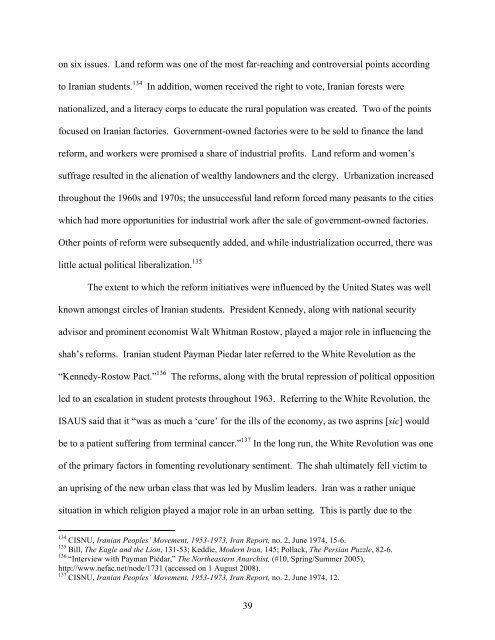AN AUGURY OF REVOLUTION: THE IRANIAN STUDENT ...
AN AUGURY OF REVOLUTION: THE IRANIAN STUDENT ...
AN AUGURY OF REVOLUTION: THE IRANIAN STUDENT ...
You also want an ePaper? Increase the reach of your titles
YUMPU automatically turns print PDFs into web optimized ePapers that Google loves.
on six issues. Land reform was one of the most far-reaching and controversial points according<br />
to Iranian students. 134 In addition, women received the right to vote, Iranian forests were<br />
nationalized, and a literacy corps to educate the rural population was created. Two of the points<br />
focused on Iranian factories. Government-owned factories were to be sold to finance the land<br />
reform, and workers were promised a share of industrial profits. Land reform and women’s<br />
suffrage resulted in the alienation of wealthy landowners and the clergy. Urbanization increased<br />
throughout the 1960s and 1970s; the unsuccessful land reform forced many peasants to the cities<br />
which had more opportunities for industrial work after the sale of government-owned factories.<br />
Other points of reform were subsequently added, and while industrialization occurred, there was<br />
little actual political liberalization. 135<br />
The extent to which the reform initiatives were influenced by the United States was well<br />
known amongst circles of Iranian students. President Kennedy, along with national security<br />
advisor and prominent economist Walt Whitman Rostow, played a major role in influencing the<br />
shah’s reforms. Iranian student Payman Piedar later referred to the White Revolution as the<br />
“Kennedy-Rostow Pact.” 136<br />
The reforms, along with the brutal repression of political opposition<br />
led to an escalation in student protests throughout 1963. Referring to the White Revolution, the<br />
ISAUS said that it “was as much a ‘cure’ for the ills of the economy, as two asprins [sic] would<br />
be to a patient suffering from terminal cancer.” 137 In the long run, the White Revolution was one<br />
of the primary factors in fomenting revolutionary sentiment. The shah ultimately fell victim to<br />
an uprising of the new urban class that was led by Muslim leaders. Iran was a rather unique<br />
situation in which religion played a major role in an urban setting. This is partly due to the<br />
134 CISNU, Iranian Peoples’ Movement, 1953-1973, Iran Report, no. 2, June 1974, 15-6.<br />
135 Bill, The Eagle and the Lion, 131-53; Keddie, Modern Iran, 145; Pollack, The Persian Puzzle, 82-6.<br />
136 “Interview with Payman Piedar,” The Northeastern Anarchist, (#10, Spring/Summer 2005),<br />
http://www.nefac.net/node/1731 (accessed on 1 August 2008).<br />
137 CISNU, Iranian Peoples’ Movement, 1953-1973, Iran Report, no. 2, June 1974, 12.<br />
39















